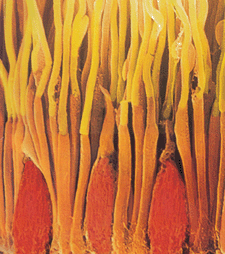| Email me | Jennifer Tareila Home |
| Project home |
The Eye |
Retinal
And Rhodopsin |
Absorption
Spectra |
WebMo Job 992 |
Applications |
Links and Refs |
| The human retina has approximately 100,000
rods and 3,000,000 cones. The ratio of rods to cones is different in
different species. In mammals, the rods are approximately 1µm
by 40µm. Rods have stacks of approximately 1,000 disks 16nm thick that
contain chromophores. The inner segment contains the nucleus and typical cellular
component, such as the mitochondria. The chromophore is contained in the
outer segment of the rod. Rods and cones absorb different wavelengths because the cis-retinal is joined to different proteins in these structures, so that the chromophore differs between them. There are 3 different proteins that the retinal can be joined to in the cones, which are responsible for color vision. Rods are responsible for vision in dim light. Different animals have different proteins in their rods and cones. When light reaches the rods/cones and is absorbed, there is a conformational change made in the retinal molecule. The molecule changes from the 11-cis-retinal isomer to the all-trans-isomer. This change initiates a series of G-coupled protein changes that lead to a nerve impulse transmission, which results in vision. The chromophores, or photo optically active portions, of the rod are composed of rhodopsin. |

Image (10)photomicrograph of rods: http://cas.bellarmine.edu/tietjen/HumanBioogy/Sensory/Image30.gif |

scanEMphoto.jpe from http://webvision.med.utah.edu/photo1.html#pigments |
| Project home |
The Eye |
Retinal
And Rhodopsin |
Absorption
Spectra |
WebMo Job 992 |
Applications |
Links and Refs |